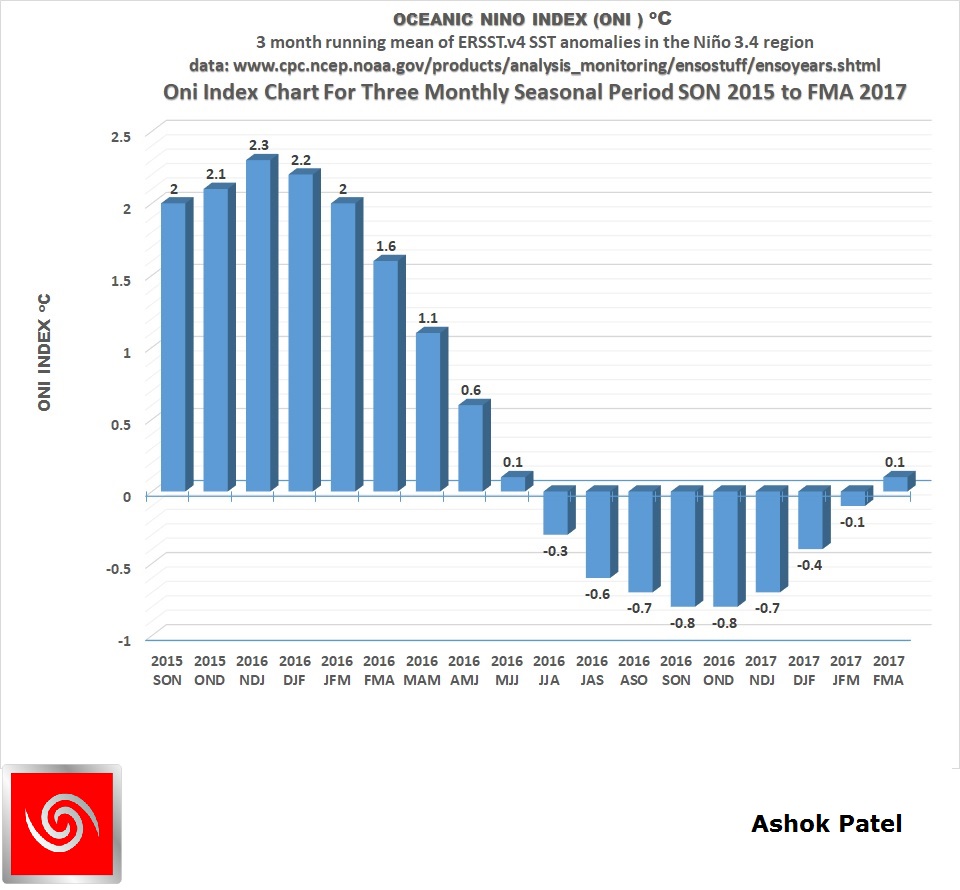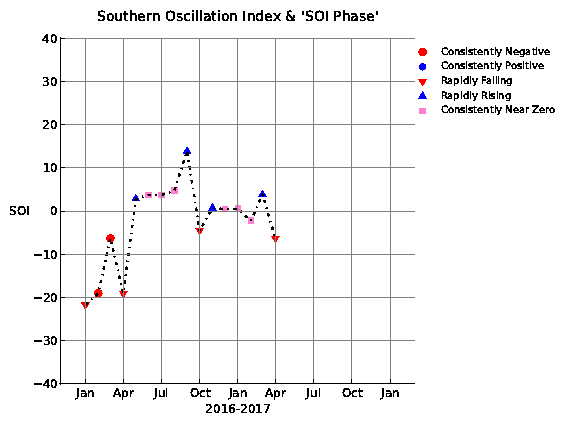ENSO Status on 5th May 2017
The ONI is based on SST departures from average in the Niño 3.4 region, and is a principal measure for monitoring, assessing, and predicting ENSO. Defined as the three-month running-mean SST departures in the Niño 3.4 region. Departures are based on a set of improved homogeneous historical SST analyses (Extended Reconstructed SST – ERSST.v4). The SST reconstruction methodology is described in Huang et al., 2015, J. Climate, vol. 28, 911-930.
CPC uses current Climatology based on 1986-2015 which has been changed late last year from base years 1981-2010. Explanation about Climatology base years change is given here.
NOAA Operational Definitions for El Niño and La Niña, El Niño: characterized by a positive ONI greater than or equal to +0.5ºC. La Niña: characterized by a negative ONI less than or equal to -0.5ºC. By historical standards, to be classified as a full-fledged El Niño or La Niña episode, these thresholds must be exceeded for a period of at least 5 consecutive overlapping 3-month seasons.
CPC considers El Niño or La Niña conditions to occur when the monthly Niño3.4 OISST departures meet or exceed +/- 0.5ºC along with consistent atmospheric features. These anomalies must also be forecast to persist for 3 consecutive months.
Enso neutral conditions have prevailed after the demise of short lived La Nina having last 3-monthly season as NDJ 2017.
ONI Index for DJF 2017 was -0.4ºC, JFM 2017 is -0.2ºC FMA 2017 is +0.1ºC and hence the Nino 3.4 Region of Pacific Ocean continues to remain in ENSO Neutral zone.
Latest Oceanic Nino Index (ONI) Graph Showing Enso Neutral Event For Last Three 3- Monthly Seasons Ending April 2017
The Table below shows the monthly SST of Nino3.4 Region and the Climate adjusted normal SST and SST anomaly for last two years. Climate Base 1986-2015.
Period Nino3.4 ClimAdjust YR MON Temp.ºC Temp.ºC ANOM ºC 2015 4 28.59 27.86 0.73 2015 5 28.83 27.98 0.85 2015 6 28.70 27.76 0.94 2015 7 28.50 27.37 1.13 2015 8 28.47 27.02 1.45 2015 9 28.62 26.94 1.68 2015 10 28.86 26.91 1.95 2015 11 29.14 26.88 2.25 2015 12 29.04 26.80 2.24 2016 1 28.95 26.61 2.33 2016 2 28.89 26.80 2.09 2016 3 28.86 27.32 1.54 2016 4 28.96 27.86 1.10 2016 5 28.59 27.98 0.60 2016 6 27.81 27.76 0.05 2016 7 26.98 27.37 -0.39 2016 8 26.39 27.02 -0.63 2016 9 26.20 26.94 -0.74 2016 10 26.04 26.91 -0.87 2016 11 25.96 26.88 -0.93 2016 12 26.08 26.80 -0.72 2017 1 26.24 26.61 -0.37 2017 2 26.63 26.80 -0.17 2017 3 27.49 27.32 0.17 2017 4 28.29 27.86 0.43
CPC considers El Niño or La Niña conditions to occur when the monthly Niño3.4 OISST departures meet or exceed +/- 0.5°C along with consistent atmospheric features. These anomalies must also be forecast to persist for 3 consecutive months.
Southern Oscillation Index
As per BOM, Australia:
The 30-day Southern Oscillation Index (SOI) to 24 April was −6.6 (90-day value −0.3). SOI values have generally been within the neutral range since mid-October.
The latest 30-day Southern Oscillation Index (SOI) on 3rd May 2017 is -5.7 within the neutral ENSO range.
Sustained positive values of the SOI above +7 typically indicate La Niña while sustained negative values below −7 typically indicate El Niño. Values between about +7 and −7 generally indicate neutral conditions.
SOI Monthly graph up to April 2017 as per The Long Paddock – Queensland Government.
SOI was -6.31 at the end of April 2017 and -6.35 on 5th May 2017 as per The Long Paddock – Queensland Government.
Summary by: Climate Prediction Center / NCEP Dated 1st May 2017
ENSO Alert System Status: Not Active
ENSO-neutral conditions are present.* Equatorial sea surface temperatures (SSTs) are near-average across the central Pacific. They are above-average in the eastern Pacific Ocean. ENSO-neutral conditions are favored to continue through at least the Northern Hemisphere spring 2017, with increasing chances for El Niño development by late summer and fall.*
* Note: These statements are updated once a month (2nd Thursday of each month) in association with the ENSO Diagnostics Discussion, which can be found by clicking here
As per BOM -Australia latter part of April 2017
ENSO neutral, but tropical Pacific waters continue to warm – El Niño WATCH Remains:
The El Niño–Southern Oscillation (ENSO) remains neutral. However, the Bureau’s ENSO Outlook status is at El Niño WATCH, indicating around a 50% chance of El Niño developing in 2017.
Ashok Patel’s Final Note: Full Fledged El Nino Not Possible During The Indian Southwest Monsoon 2017 Using NOAA Criteria.
The current SST of Nino 3.4 region is below +0.5°C at +0.43°C and also the last ONI Index available is FMA 2017 at just +0.1°C which is yet in the Enso Neutral zone. The SST for May is not expected to reach +0.9°C and hence the ONI Index for MAM 2017 will be < 0.5°C. Even if MAM 2017 reaches +0.5, and only if the NINO 3.4 region heats up continuously for the next Four 3-monthly seasons namely AMJ 2017, MJJ 2017, JJA 2017 & JAS 2017 and if all the ONI indexes manages to remain equal to or above 0.5°C only then it will qualify for a Full fledged El Nino as per NOAA criteria. However, the Southwest Monsoon 2017 would have already ended by that time.
અશોક પટેલ ની નોંધ :
ઓસ્ટ્રેલિયા ની BOM સંસ્થા મુજબ 2017 માં એલ નિનો થવા ની 50% શક્યતા ના એંધાણ આપવામાં આવ્યા હોવા છતાં મારુ માનવું છે કે આગામી ચોમાસા દરમિયાન વિધિવત એલ નિનો (NOAA, U.S. ના માપ દંડ મુજબ ) શક્ય નથી. વિધિવત એલ નિનો જો ડિક્લેર થાય તો પણ ભારત નું દક્ષિણ પશ્ચિમ ચોમાસુ ત્યારે પૂરું થઇ ગયું હશે.
All earlier updates are listed below:
Click here for Update “Full Fledged El Nino Not Possible During The Indian Southwest Monsoon 2017”
Click here for Update “ENSO Neutral Conditions At End Of February 2017”
Click here for Update “2016/17 Qualifies As A La Nina Event”
Click here for Update “Enso Neutral Conditions At End Of October 2016”
Click here for Update “Full Fledged La Nina Not Possible During 2016”
Click here for Update “Demise Of El Nino Brings ENSO Neutral Conditions At End Of July 2016”
Click here for Update “Moderate El Nino Persists Till End Of May 2016”
Click here for Update “Strong El Nino Persists Till April 2016”
Click here for Update “NOAA ERSST.v4 & ERSST.v3b & Effects On ENSO Events”
Click here for Update “Yet A Weak El Nino – 6th June 2105”
Click here for Update “El Nino Update – 5th May 2015”
Click here for Update “Weak El Nino Develops March 2015”
Click here for Update “El Nino Status – 6th March 2015”
Click here for Update “El Nino Status – 7th February 2015”
Click here for Update “El Nino Status – 6th January 2015”
Click here for Update “El Nino Status 6th November 2014”


